Analytical Report: H&M's Strategies in the Fashion Market - MKTG 1170
VerifiedAdded on 2023/06/04
|16
|5191
|87
Report
AI Summary
This report provides an in-depth analysis of Hennes & Mauritz (H&M), a Swedish fashion organization, examining its environmental strategies through SWOT analysis, industry analysis using Porter's Five Forces, portfolio assessment, and overall business strategies. The report highlights H&M's strengths, such as its extensive product range, unique brand identities, and global presence, while also addressing weaknesses like dependency on third-party suppliers and following trends rather than leading them. Opportunities for expansion in emerging markets and e-commerce are discussed, alongside threats like intense competition and foreign exchange fluctuations. The analysis culminates in general and guerrilla marketing recommendations aimed at enhancing H&M's market position and future growth, emphasizing the importance of adapting to evolving fashion trends and leveraging digital platforms. The report concludes that H&M is well-positioned but must continue to innovate and address its weaknesses to maintain its competitive edge. Desklib provides comprehensive study tools and resources, including similar reports and solved assignments, for students seeking academic support.

RUNNING HEAD: Strategies of a fashion organization
0
H & M
Strategies of a fashion organization
0
H & M
Strategies of a fashion organization
Paraphrase This Document
Need a fresh take? Get an instant paraphrase of this document with our AI Paraphraser
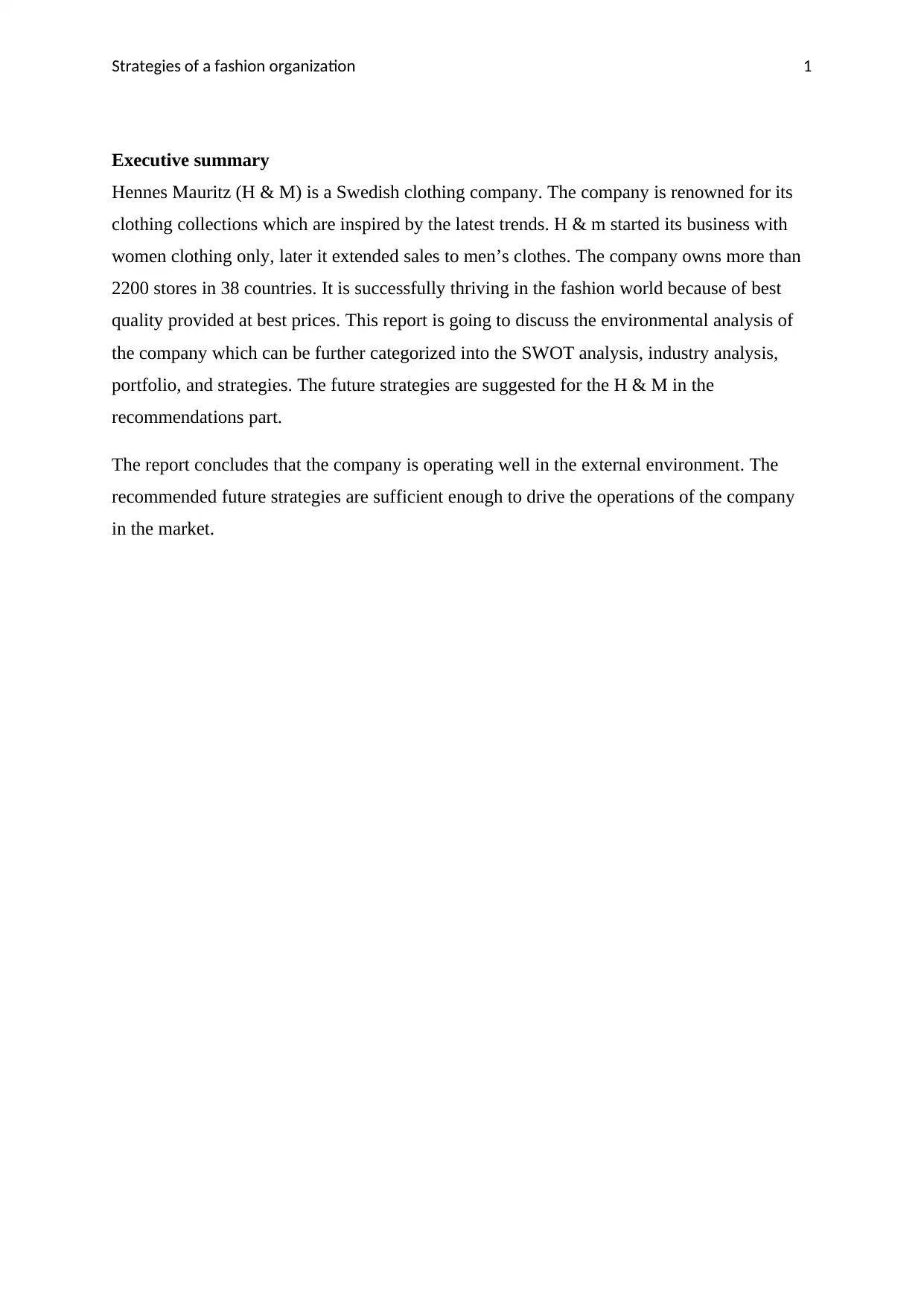
Strategies of a fashion organization 1
Executive summary
Hennes Mauritz (H & M) is a Swedish clothing company. The company is renowned for its
clothing collections which are inspired by the latest trends. H & m started its business with
women clothing only, later it extended sales to men’s clothes. The company owns more than
2200 stores in 38 countries. It is successfully thriving in the fashion world because of best
quality provided at best prices. This report is going to discuss the environmental analysis of
the company which can be further categorized into the SWOT analysis, industry analysis,
portfolio, and strategies. The future strategies are suggested for the H & M in the
recommendations part.
The report concludes that the company is operating well in the external environment. The
recommended future strategies are sufficient enough to drive the operations of the company
in the market.
Executive summary
Hennes Mauritz (H & M) is a Swedish clothing company. The company is renowned for its
clothing collections which are inspired by the latest trends. H & m started its business with
women clothing only, later it extended sales to men’s clothes. The company owns more than
2200 stores in 38 countries. It is successfully thriving in the fashion world because of best
quality provided at best prices. This report is going to discuss the environmental analysis of
the company which can be further categorized into the SWOT analysis, industry analysis,
portfolio, and strategies. The future strategies are suggested for the H & M in the
recommendations part.
The report concludes that the company is operating well in the external environment. The
recommended future strategies are sufficient enough to drive the operations of the company
in the market.
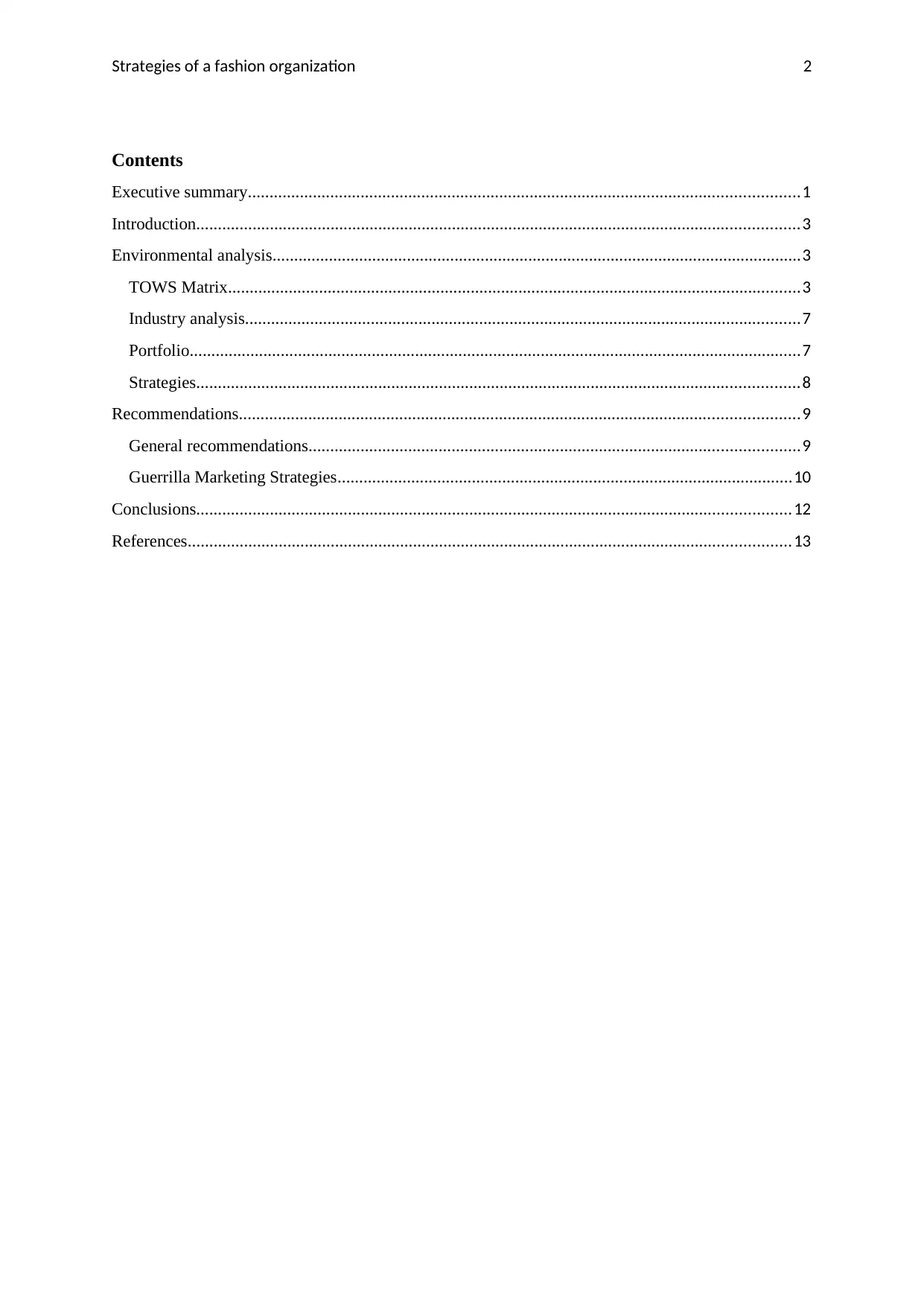
Strategies of a fashion organization 2
Contents
Executive summary...............................................................................................................................1
Introduction...........................................................................................................................................3
Environmental analysis..........................................................................................................................3
TOWS Matrix....................................................................................................................................3
Industry analysis................................................................................................................................7
Portfolio.............................................................................................................................................7
Strategies...........................................................................................................................................8
Recommendations.................................................................................................................................9
General recommendations.................................................................................................................9
Guerrilla Marketing Strategies.........................................................................................................10
Conclusions.........................................................................................................................................12
References...........................................................................................................................................13
Contents
Executive summary...............................................................................................................................1
Introduction...........................................................................................................................................3
Environmental analysis..........................................................................................................................3
TOWS Matrix....................................................................................................................................3
Industry analysis................................................................................................................................7
Portfolio.............................................................................................................................................7
Strategies...........................................................................................................................................8
Recommendations.................................................................................................................................9
General recommendations.................................................................................................................9
Guerrilla Marketing Strategies.........................................................................................................10
Conclusions.........................................................................................................................................12
References...........................................................................................................................................13
⊘ This is a preview!⊘
Do you want full access?
Subscribe today to unlock all pages.

Trusted by 1+ million students worldwide

Strategies of a fashion organization 3
Introduction
Hennes & Mauritz (H & M) is a Swedish fashion organization and best known for the fashion
clothing of men, women, teenagers, and children. H & M functions in 62 countries along with
its associated companies. It is one of the world’s leading fashion companies. H & M was
established by Erling Persson in 1947. It is registered on the Stockholm Stock Exchange in
1974. The online retailing was started by the group in 1998. The H & M group comprises
nine unique brands. The H & M group comprises nine unique brands which make great
designs and area accessible to everybody. These brands are H & M, Monki, COS, Cheap
Monday, H& M Home, Arke, Afound, Weekday & other stories. Each brand of the group
works with the aim of constant improvement. The brands engage with the customers in
stores, online as well as social media platforms. The group also integrates physical stores
with the digital channels. The group leads the way towards a comprehensive and sustainable
world. It has a substantial online presence with online shopping accessible in more than 33
countries. The company collaborates with the fashion designers time on time such as Karl
Lagerfeld, Viktor and Rolf, Madonna and Roberto Cavalli. The group takes just two weeks to
introduce a new product to the stores whereas other fashion brand takes at least 6 months.
The company employs designers who can watch for the latest fashion trends and can push the
products to the stores.
The group makes use of strategies and invests in analytics to respond faster to the customer’s
needs. The distribution strategy is focused on integrating physical and digital stores and roll
out online stores in the countries. The company faces huge competition from the unorganized
sector so it makes use of competitive analysis in its strategy. The company serves a large
number of the customers. So, it primarily focuses on the upper middle and upper-income
group which is in the age group of 15-40 years.
Environmental analysis
TOWS Matrix
H & M is the 2nd largest fashion seller in the world. It is well-known for its fast-changing
clothing. The TOWS matrix is helpful tool to the company as it generates, compares and
selects strategies. It makes a trade-off between external and internal factors. The strengths
Introduction
Hennes & Mauritz (H & M) is a Swedish fashion organization and best known for the fashion
clothing of men, women, teenagers, and children. H & M functions in 62 countries along with
its associated companies. It is one of the world’s leading fashion companies. H & M was
established by Erling Persson in 1947. It is registered on the Stockholm Stock Exchange in
1974. The online retailing was started by the group in 1998. The H & M group comprises
nine unique brands. The H & M group comprises nine unique brands which make great
designs and area accessible to everybody. These brands are H & M, Monki, COS, Cheap
Monday, H& M Home, Arke, Afound, Weekday & other stories. Each brand of the group
works with the aim of constant improvement. The brands engage with the customers in
stores, online as well as social media platforms. The group also integrates physical stores
with the digital channels. The group leads the way towards a comprehensive and sustainable
world. It has a substantial online presence with online shopping accessible in more than 33
countries. The company collaborates with the fashion designers time on time such as Karl
Lagerfeld, Viktor and Rolf, Madonna and Roberto Cavalli. The group takes just two weeks to
introduce a new product to the stores whereas other fashion brand takes at least 6 months.
The company employs designers who can watch for the latest fashion trends and can push the
products to the stores.
The group makes use of strategies and invests in analytics to respond faster to the customer’s
needs. The distribution strategy is focused on integrating physical and digital stores and roll
out online stores in the countries. The company faces huge competition from the unorganized
sector so it makes use of competitive analysis in its strategy. The company serves a large
number of the customers. So, it primarily focuses on the upper middle and upper-income
group which is in the age group of 15-40 years.
Environmental analysis
TOWS Matrix
H & M is the 2nd largest fashion seller in the world. It is well-known for its fast-changing
clothing. The TOWS matrix is helpful tool to the company as it generates, compares and
selects strategies. It makes a trade-off between external and internal factors. The strengths
Paraphrase This Document
Need a fresh take? Get an instant paraphrase of this document with our AI Paraphraser
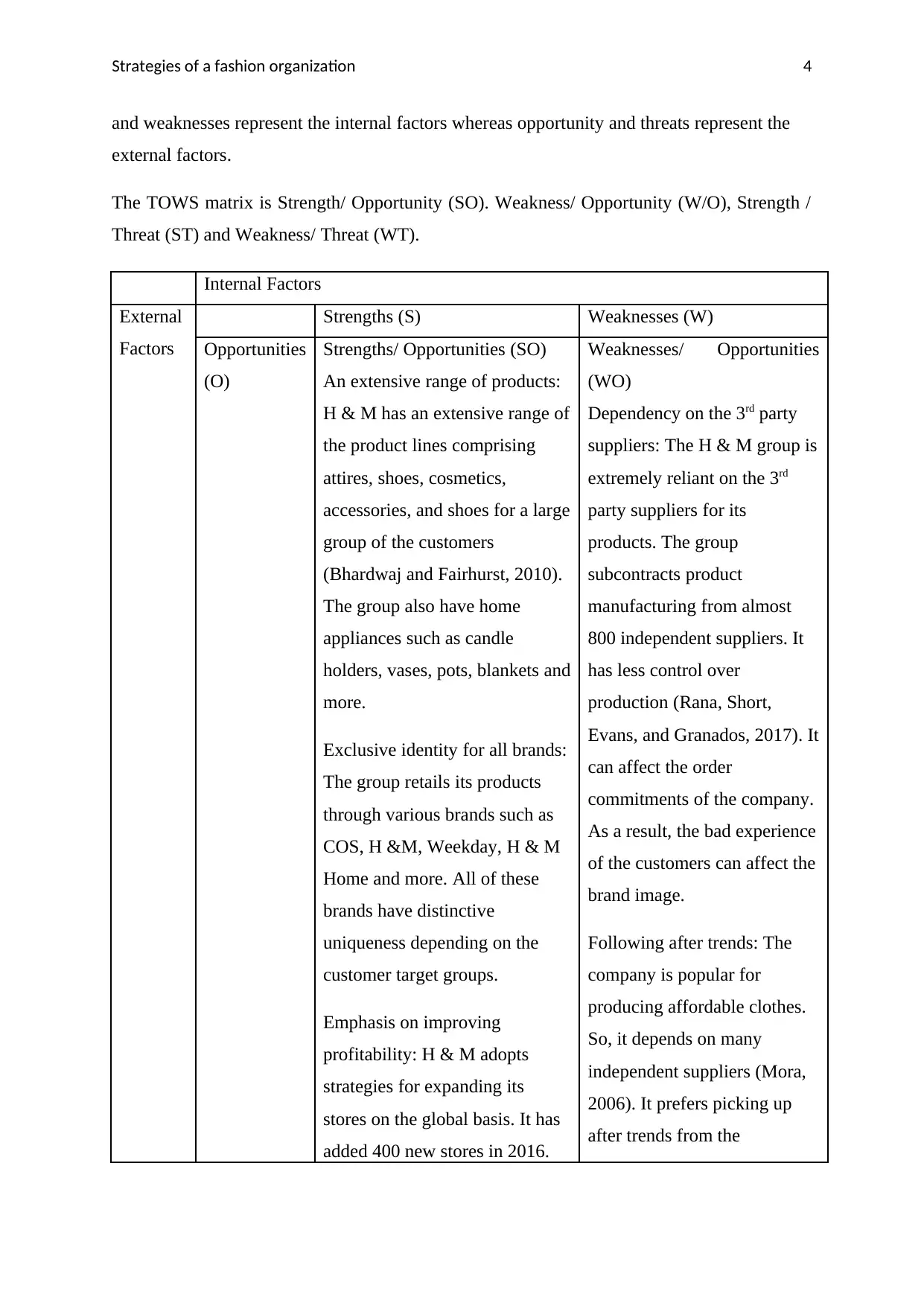
Strategies of a fashion organization 4
and weaknesses represent the internal factors whereas opportunity and threats represent the
external factors.
The TOWS matrix is Strength/ Opportunity (SO). Weakness/ Opportunity (W/O), Strength /
Threat (ST) and Weakness/ Threat (WT).
Internal Factors
External
Factors
Strengths (S) Weaknesses (W)
Opportunities
(O)
Strengths/ Opportunities (SO)
An extensive range of products:
H & M has an extensive range of
the product lines comprising
attires, shoes, cosmetics,
accessories, and shoes for a large
group of the customers
(Bhardwaj and Fairhurst, 2010).
The group also have home
appliances such as candle
holders, vases, pots, blankets and
more.
Exclusive identity for all brands:
The group retails its products
through various brands such as
COS, H &M, Weekday, H & M
Home and more. All of these
brands have distinctive
uniqueness depending on the
customer target groups.
Emphasis on improving
profitability: H & M adopts
strategies for expanding its
stores on the global basis. It has
added 400 new stores in 2016.
Weaknesses/ Opportunities
(WO)
Dependency on the 3rd party
suppliers: The H & M group is
extremely reliant on the 3rd
party suppliers for its
products. The group
subcontracts product
manufacturing from almost
800 independent suppliers. It
has less control over
production (Rana, Short,
Evans, and Granados, 2017). It
can affect the order
commitments of the company.
As a result, the bad experience
of the customers can affect the
brand image.
Following after trends: The
company is popular for
producing affordable clothes.
So, it depends on many
independent suppliers (Mora,
2006). It prefers picking up
after trends from the
and weaknesses represent the internal factors whereas opportunity and threats represent the
external factors.
The TOWS matrix is Strength/ Opportunity (SO). Weakness/ Opportunity (W/O), Strength /
Threat (ST) and Weakness/ Threat (WT).
Internal Factors
External
Factors
Strengths (S) Weaknesses (W)
Opportunities
(O)
Strengths/ Opportunities (SO)
An extensive range of products:
H & M has an extensive range of
the product lines comprising
attires, shoes, cosmetics,
accessories, and shoes for a large
group of the customers
(Bhardwaj and Fairhurst, 2010).
The group also have home
appliances such as candle
holders, vases, pots, blankets and
more.
Exclusive identity for all brands:
The group retails its products
through various brands such as
COS, H &M, Weekday, H & M
Home and more. All of these
brands have distinctive
uniqueness depending on the
customer target groups.
Emphasis on improving
profitability: H & M adopts
strategies for expanding its
stores on the global basis. It has
added 400 new stores in 2016.
Weaknesses/ Opportunities
(WO)
Dependency on the 3rd party
suppliers: The H & M group is
extremely reliant on the 3rd
party suppliers for its
products. The group
subcontracts product
manufacturing from almost
800 independent suppliers. It
has less control over
production (Rana, Short,
Evans, and Granados, 2017). It
can affect the order
commitments of the company.
As a result, the bad experience
of the customers can affect the
brand image.
Following after trends: The
company is popular for
producing affordable clothes.
So, it depends on many
independent suppliers (Mora,
2006). It prefers picking up
after trends from the
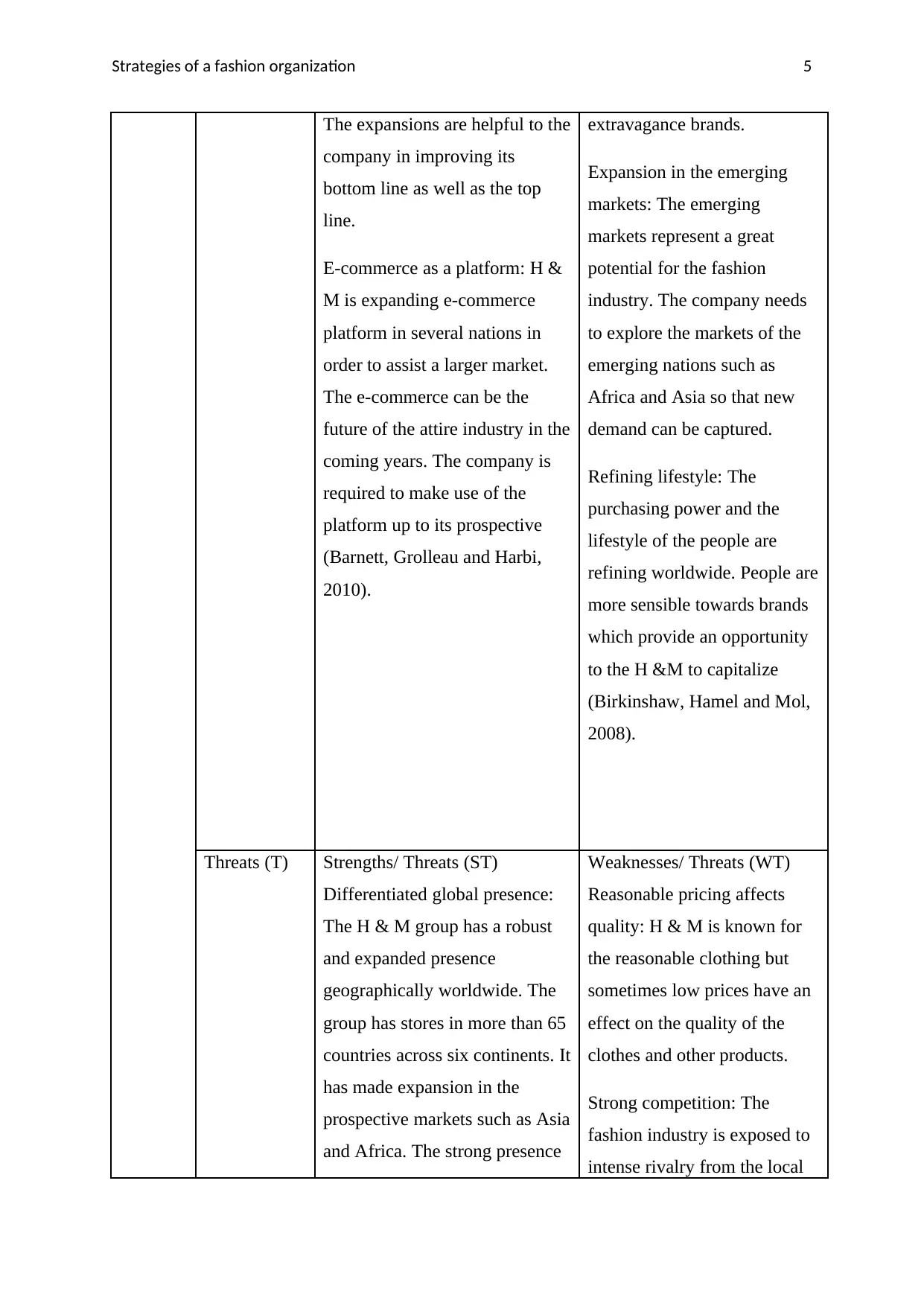
Strategies of a fashion organization 5
The expansions are helpful to the
company in improving its
bottom line as well as the top
line.
E-commerce as a platform: H &
M is expanding e-commerce
platform in several nations in
order to assist a larger market.
The e-commerce can be the
future of the attire industry in the
coming years. The company is
required to make use of the
platform up to its prospective
(Barnett, Grolleau and Harbi,
2010).
extravagance brands.
Expansion in the emerging
markets: The emerging
markets represent a great
potential for the fashion
industry. The company needs
to explore the markets of the
emerging nations such as
Africa and Asia so that new
demand can be captured.
Refining lifestyle: The
purchasing power and the
lifestyle of the people are
refining worldwide. People are
more sensible towards brands
which provide an opportunity
to the H &M to capitalize
(Birkinshaw, Hamel and Mol,
2008).
Threats (T) Strengths/ Threats (ST)
Differentiated global presence:
The H & M group has a robust
and expanded presence
geographically worldwide. The
group has stores in more than 65
countries across six continents. It
has made expansion in the
prospective markets such as Asia
and Africa. The strong presence
Weaknesses/ Threats (WT)
Reasonable pricing affects
quality: H & M is known for
the reasonable clothing but
sometimes low prices have an
effect on the quality of the
clothes and other products.
Strong competition: The
fashion industry is exposed to
intense rivalry from the local
The expansions are helpful to the
company in improving its
bottom line as well as the top
line.
E-commerce as a platform: H &
M is expanding e-commerce
platform in several nations in
order to assist a larger market.
The e-commerce can be the
future of the attire industry in the
coming years. The company is
required to make use of the
platform up to its prospective
(Barnett, Grolleau and Harbi,
2010).
extravagance brands.
Expansion in the emerging
markets: The emerging
markets represent a great
potential for the fashion
industry. The company needs
to explore the markets of the
emerging nations such as
Africa and Asia so that new
demand can be captured.
Refining lifestyle: The
purchasing power and the
lifestyle of the people are
refining worldwide. People are
more sensible towards brands
which provide an opportunity
to the H &M to capitalize
(Birkinshaw, Hamel and Mol,
2008).
Threats (T) Strengths/ Threats (ST)
Differentiated global presence:
The H & M group has a robust
and expanded presence
geographically worldwide. The
group has stores in more than 65
countries across six continents. It
has made expansion in the
prospective markets such as Asia
and Africa. The strong presence
Weaknesses/ Threats (WT)
Reasonable pricing affects
quality: H & M is known for
the reasonable clothing but
sometimes low prices have an
effect on the quality of the
clothes and other products.
Strong competition: The
fashion industry is exposed to
intense rivalry from the local
⊘ This is a preview!⊘
Do you want full access?
Subscribe today to unlock all pages.

Trusted by 1+ million students worldwide

Strategies of a fashion organization 6
of the H & M worldwide
minimizes the business risks
(Pedersen and Andersen, 2015).
Strong financial performance:
The strong financial
performance of the company can
be evaluated in the previous
financial years. The group
attained profits of 19.4% in the
financial year of 2014. The
robust financial performance of
the group enhances the
confidence of the customers and
offers financial flexibility to the
company.
Developing fashion trends: The
fashion industry is subjected to
rapid changes as trends keep on
moving. The social media has an
important role behind this. So, H
& M need to launch products as
per the latest trends otherwise it
can lag behind.
E-commerce permits new
entrants: E-commerce represents
an advantage as well as a threat
to the company as it allows new
brands to exist on the same
platform. The new entry is
potential enough to affect the
business of H & M (Mihm,
and international brands. H &
M is required to be attentive of
the competition along with the
new trends and the fashion
(Rost and Osterloh, 2009).
Risk of foreign exchange
fluctuations: The currency of
the H & M group is Swedish
and most of its sales are
generated from the developed
economies like Europe and the
US. The group faces the threat
of the foreign exchange rate as
it affects the profitability.
of the H & M worldwide
minimizes the business risks
(Pedersen and Andersen, 2015).
Strong financial performance:
The strong financial
performance of the company can
be evaluated in the previous
financial years. The group
attained profits of 19.4% in the
financial year of 2014. The
robust financial performance of
the group enhances the
confidence of the customers and
offers financial flexibility to the
company.
Developing fashion trends: The
fashion industry is subjected to
rapid changes as trends keep on
moving. The social media has an
important role behind this. So, H
& M need to launch products as
per the latest trends otherwise it
can lag behind.
E-commerce permits new
entrants: E-commerce represents
an advantage as well as a threat
to the company as it allows new
brands to exist on the same
platform. The new entry is
potential enough to affect the
business of H & M (Mihm,
and international brands. H &
M is required to be attentive of
the competition along with the
new trends and the fashion
(Rost and Osterloh, 2009).
Risk of foreign exchange
fluctuations: The currency of
the H & M group is Swedish
and most of its sales are
generated from the developed
economies like Europe and the
US. The group faces the threat
of the foreign exchange rate as
it affects the profitability.
Paraphrase This Document
Need a fresh take? Get an instant paraphrase of this document with our AI Paraphraser
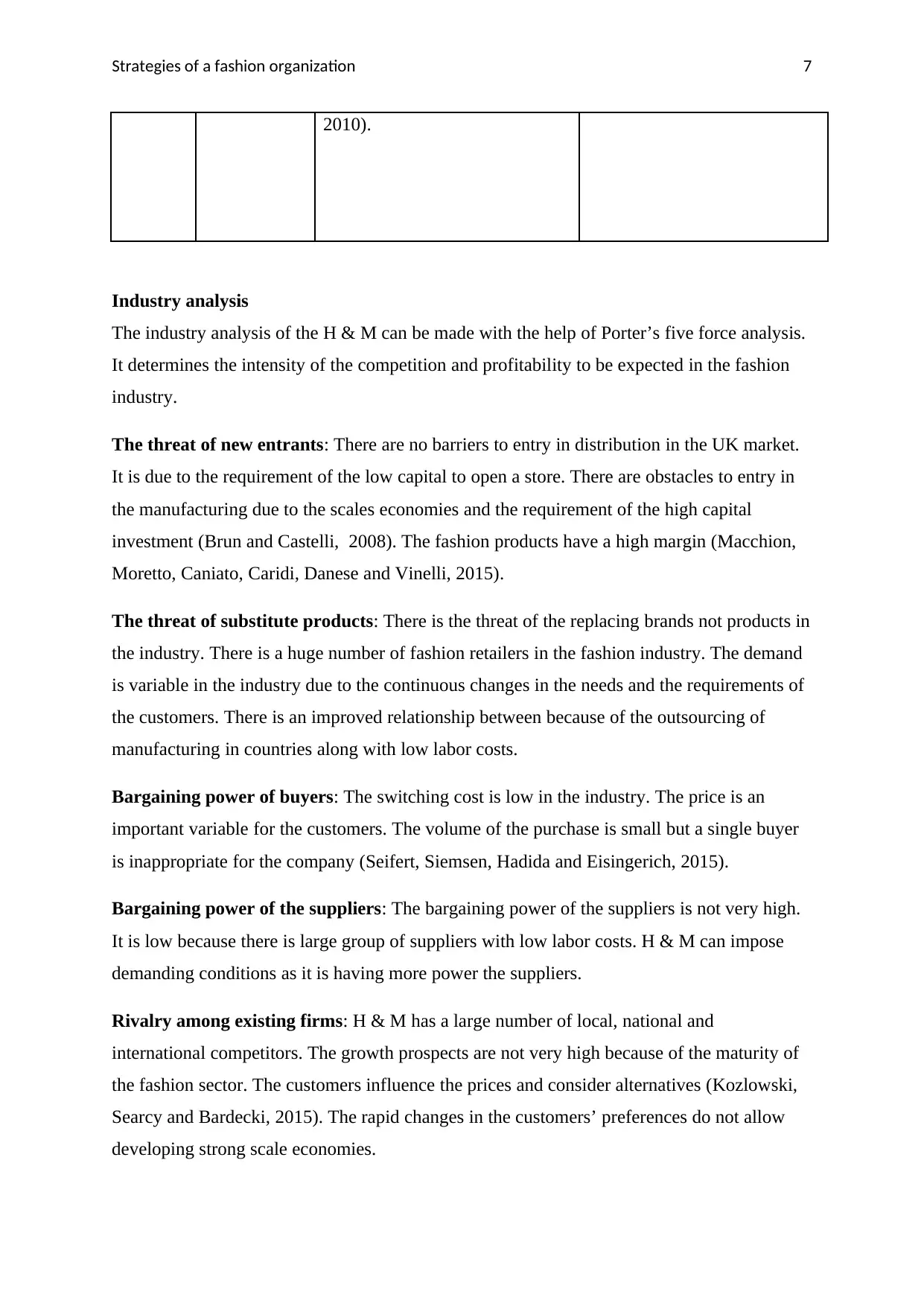
Strategies of a fashion organization 7
2010).
Industry analysis
The industry analysis of the H & M can be made with the help of Porter’s five force analysis.
It determines the intensity of the competition and profitability to be expected in the fashion
industry.
The threat of new entrants: There are no barriers to entry in distribution in the UK market.
It is due to the requirement of the low capital to open a store. There are obstacles to entry in
the manufacturing due to the scales economies and the requirement of the high capital
investment (Brun and Castelli, 2008). The fashion products have a high margin (Macchion,
Moretto, Caniato, Caridi, Danese and Vinelli, 2015).
The threat of substitute products: There is the threat of the replacing brands not products in
the industry. There is a huge number of fashion retailers in the fashion industry. The demand
is variable in the industry due to the continuous changes in the needs and the requirements of
the customers. There is an improved relationship between because of the outsourcing of
manufacturing in countries along with low labor costs.
Bargaining power of buyers: The switching cost is low in the industry. The price is an
important variable for the customers. The volume of the purchase is small but a single buyer
is inappropriate for the company (Seifert, Siemsen, Hadida and Eisingerich, 2015).
Bargaining power of the suppliers: The bargaining power of the suppliers is not very high.
It is low because there is large group of suppliers with low labor costs. H & M can impose
demanding conditions as it is having more power the suppliers.
Rivalry among existing firms: H & M has a large number of local, national and
international competitors. The growth prospects are not very high because of the maturity of
the fashion sector. The customers influence the prices and consider alternatives (Kozlowski,
Searcy and Bardecki, 2015). The rapid changes in the customers’ preferences do not allow
developing strong scale economies.
2010).
Industry analysis
The industry analysis of the H & M can be made with the help of Porter’s five force analysis.
It determines the intensity of the competition and profitability to be expected in the fashion
industry.
The threat of new entrants: There are no barriers to entry in distribution in the UK market.
It is due to the requirement of the low capital to open a store. There are obstacles to entry in
the manufacturing due to the scales economies and the requirement of the high capital
investment (Brun and Castelli, 2008). The fashion products have a high margin (Macchion,
Moretto, Caniato, Caridi, Danese and Vinelli, 2015).
The threat of substitute products: There is the threat of the replacing brands not products in
the industry. There is a huge number of fashion retailers in the fashion industry. The demand
is variable in the industry due to the continuous changes in the needs and the requirements of
the customers. There is an improved relationship between because of the outsourcing of
manufacturing in countries along with low labor costs.
Bargaining power of buyers: The switching cost is low in the industry. The price is an
important variable for the customers. The volume of the purchase is small but a single buyer
is inappropriate for the company (Seifert, Siemsen, Hadida and Eisingerich, 2015).
Bargaining power of the suppliers: The bargaining power of the suppliers is not very high.
It is low because there is large group of suppliers with low labor costs. H & M can impose
demanding conditions as it is having more power the suppliers.
Rivalry among existing firms: H & M has a large number of local, national and
international competitors. The growth prospects are not very high because of the maturity of
the fashion sector. The customers influence the prices and consider alternatives (Kozlowski,
Searcy and Bardecki, 2015). The rapid changes in the customers’ preferences do not allow
developing strong scale economies.
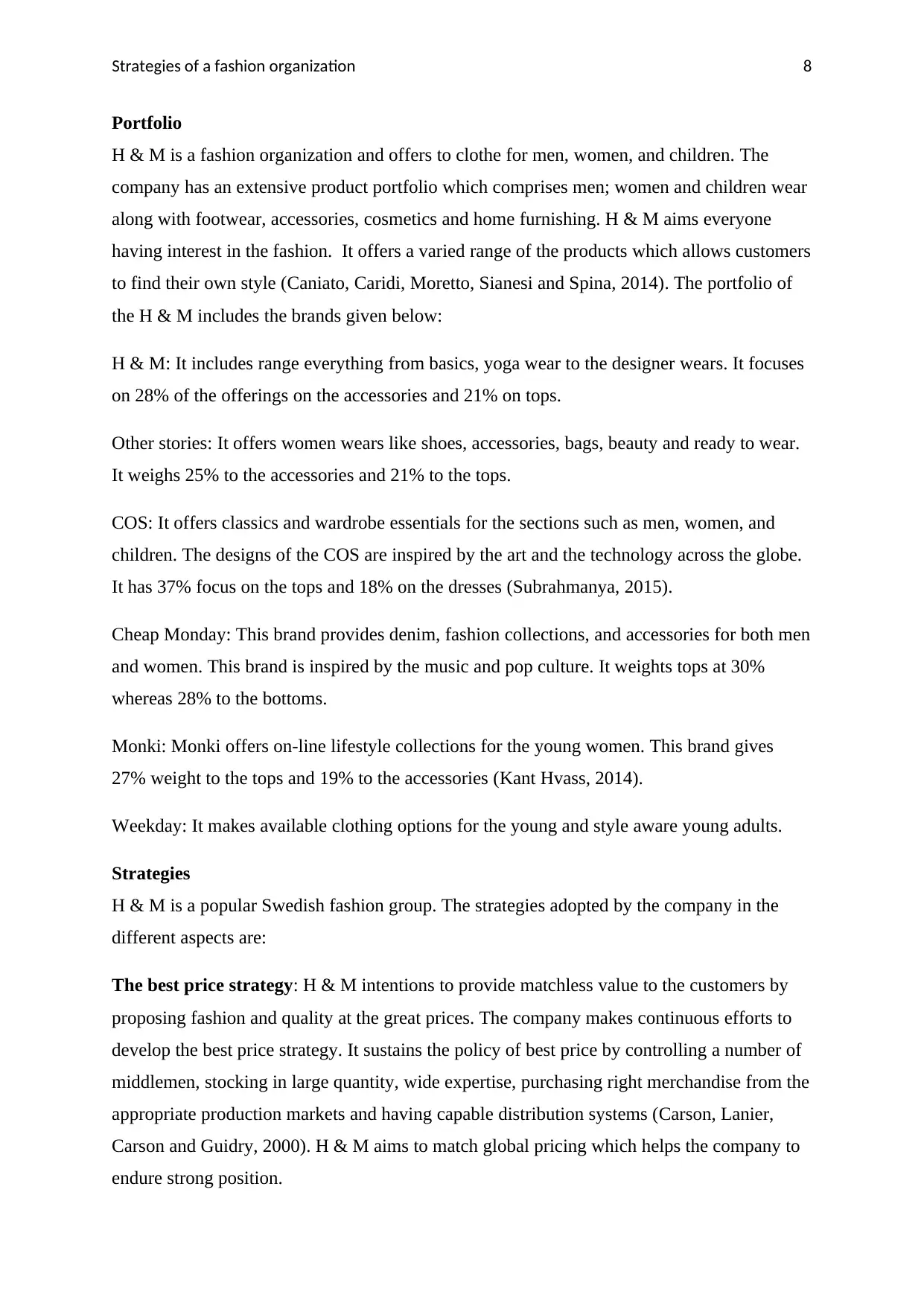
Strategies of a fashion organization 8
Portfolio
H & M is a fashion organization and offers to clothe for men, women, and children. The
company has an extensive product portfolio which comprises men; women and children wear
along with footwear, accessories, cosmetics and home furnishing. H & M aims everyone
having interest in the fashion. It offers a varied range of the products which allows customers
to find their own style (Caniato, Caridi, Moretto, Sianesi and Spina, 2014). The portfolio of
the H & M includes the brands given below:
H & M: It includes range everything from basics, yoga wear to the designer wears. It focuses
on 28% of the offerings on the accessories and 21% on tops.
Other stories: It offers women wears like shoes, accessories, bags, beauty and ready to wear.
It weighs 25% to the accessories and 21% to the tops.
COS: It offers classics and wardrobe essentials for the sections such as men, women, and
children. The designs of the COS are inspired by the art and the technology across the globe.
It has 37% focus on the tops and 18% on the dresses (Subrahmanya, 2015).
Cheap Monday: This brand provides denim, fashion collections, and accessories for both men
and women. This brand is inspired by the music and pop culture. It weights tops at 30%
whereas 28% to the bottoms.
Monki: Monki offers on-line lifestyle collections for the young women. This brand gives
27% weight to the tops and 19% to the accessories (Kant Hvass, 2014).
Weekday: It makes available clothing options for the young and style aware young adults.
Strategies
H & M is a popular Swedish fashion group. The strategies adopted by the company in the
different aspects are:
The best price strategy: H & M intentions to provide matchless value to the customers by
proposing fashion and quality at the great prices. The company makes continuous efforts to
develop the best price strategy. It sustains the policy of best price by controlling a number of
middlemen, stocking in large quantity, wide expertise, purchasing right merchandise from the
appropriate production markets and having capable distribution systems (Carson, Lanier,
Carson and Guidry, 2000). H & M aims to match global pricing which helps the company to
endure strong position.
Portfolio
H & M is a fashion organization and offers to clothe for men, women, and children. The
company has an extensive product portfolio which comprises men; women and children wear
along with footwear, accessories, cosmetics and home furnishing. H & M aims everyone
having interest in the fashion. It offers a varied range of the products which allows customers
to find their own style (Caniato, Caridi, Moretto, Sianesi and Spina, 2014). The portfolio of
the H & M includes the brands given below:
H & M: It includes range everything from basics, yoga wear to the designer wears. It focuses
on 28% of the offerings on the accessories and 21% on tops.
Other stories: It offers women wears like shoes, accessories, bags, beauty and ready to wear.
It weighs 25% to the accessories and 21% to the tops.
COS: It offers classics and wardrobe essentials for the sections such as men, women, and
children. The designs of the COS are inspired by the art and the technology across the globe.
It has 37% focus on the tops and 18% on the dresses (Subrahmanya, 2015).
Cheap Monday: This brand provides denim, fashion collections, and accessories for both men
and women. This brand is inspired by the music and pop culture. It weights tops at 30%
whereas 28% to the bottoms.
Monki: Monki offers on-line lifestyle collections for the young women. This brand gives
27% weight to the tops and 19% to the accessories (Kant Hvass, 2014).
Weekday: It makes available clothing options for the young and style aware young adults.
Strategies
H & M is a popular Swedish fashion group. The strategies adopted by the company in the
different aspects are:
The best price strategy: H & M intentions to provide matchless value to the customers by
proposing fashion and quality at the great prices. The company makes continuous efforts to
develop the best price strategy. It sustains the policy of best price by controlling a number of
middlemen, stocking in large quantity, wide expertise, purchasing right merchandise from the
appropriate production markets and having capable distribution systems (Carson, Lanier,
Carson and Guidry, 2000). H & M aims to match global pricing which helps the company to
endure strong position.
⊘ This is a preview!⊘
Do you want full access?
Subscribe today to unlock all pages.

Trusted by 1+ million students worldwide
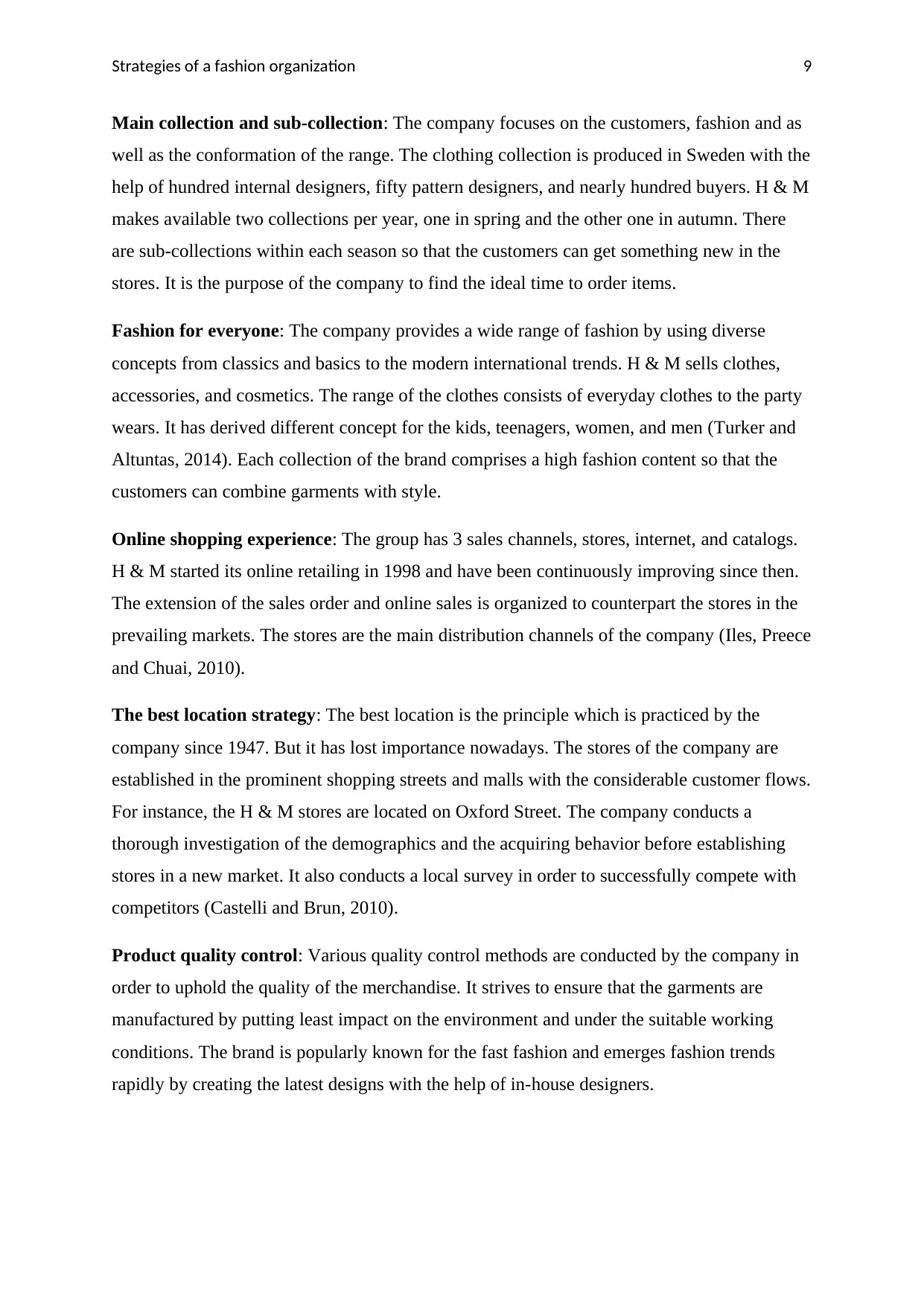
Strategies of a fashion organization 9
Main collection and sub-collection: The company focuses on the customers, fashion and as
well as the conformation of the range. The clothing collection is produced in Sweden with the
help of hundred internal designers, fifty pattern designers, and nearly hundred buyers. H & M
makes available two collections per year, one in spring and the other one in autumn. There
are sub-collections within each season so that the customers can get something new in the
stores. It is the purpose of the company to find the ideal time to order items.
Fashion for everyone: The company provides a wide range of fashion by using diverse
concepts from classics and basics to the modern international trends. H & M sells clothes,
accessories, and cosmetics. The range of the clothes consists of everyday clothes to the party
wears. It has derived different concept for the kids, teenagers, women, and men (Turker and
Altuntas, 2014). Each collection of the brand comprises a high fashion content so that the
customers can combine garments with style.
Online shopping experience: The group has 3 sales channels, stores, internet, and catalogs.
H & M started its online retailing in 1998 and have been continuously improving since then.
The extension of the sales order and online sales is organized to counterpart the stores in the
prevailing markets. The stores are the main distribution channels of the company (Iles, Preece
and Chuai, 2010).
The best location strategy: The best location is the principle which is practiced by the
company since 1947. But it has lost importance nowadays. The stores of the company are
established in the prominent shopping streets and malls with the considerable customer flows.
For instance, the H & M stores are located on Oxford Street. The company conducts a
thorough investigation of the demographics and the acquiring behavior before establishing
stores in a new market. It also conducts a local survey in order to successfully compete with
competitors (Castelli and Brun, 2010).
Product quality control: Various quality control methods are conducted by the company in
order to uphold the quality of the merchandise. It strives to ensure that the garments are
manufactured by putting least impact on the environment and under the suitable working
conditions. The brand is popularly known for the fast fashion and emerges fashion trends
rapidly by creating the latest designs with the help of in-house designers.
Main collection and sub-collection: The company focuses on the customers, fashion and as
well as the conformation of the range. The clothing collection is produced in Sweden with the
help of hundred internal designers, fifty pattern designers, and nearly hundred buyers. H & M
makes available two collections per year, one in spring and the other one in autumn. There
are sub-collections within each season so that the customers can get something new in the
stores. It is the purpose of the company to find the ideal time to order items.
Fashion for everyone: The company provides a wide range of fashion by using diverse
concepts from classics and basics to the modern international trends. H & M sells clothes,
accessories, and cosmetics. The range of the clothes consists of everyday clothes to the party
wears. It has derived different concept for the kids, teenagers, women, and men (Turker and
Altuntas, 2014). Each collection of the brand comprises a high fashion content so that the
customers can combine garments with style.
Online shopping experience: The group has 3 sales channels, stores, internet, and catalogs.
H & M started its online retailing in 1998 and have been continuously improving since then.
The extension of the sales order and online sales is organized to counterpart the stores in the
prevailing markets. The stores are the main distribution channels of the company (Iles, Preece
and Chuai, 2010).
The best location strategy: The best location is the principle which is practiced by the
company since 1947. But it has lost importance nowadays. The stores of the company are
established in the prominent shopping streets and malls with the considerable customer flows.
For instance, the H & M stores are located on Oxford Street. The company conducts a
thorough investigation of the demographics and the acquiring behavior before establishing
stores in a new market. It also conducts a local survey in order to successfully compete with
competitors (Castelli and Brun, 2010).
Product quality control: Various quality control methods are conducted by the company in
order to uphold the quality of the merchandise. It strives to ensure that the garments are
manufactured by putting least impact on the environment and under the suitable working
conditions. The brand is popularly known for the fast fashion and emerges fashion trends
rapidly by creating the latest designs with the help of in-house designers.
Paraphrase This Document
Need a fresh take? Get an instant paraphrase of this document with our AI Paraphraser
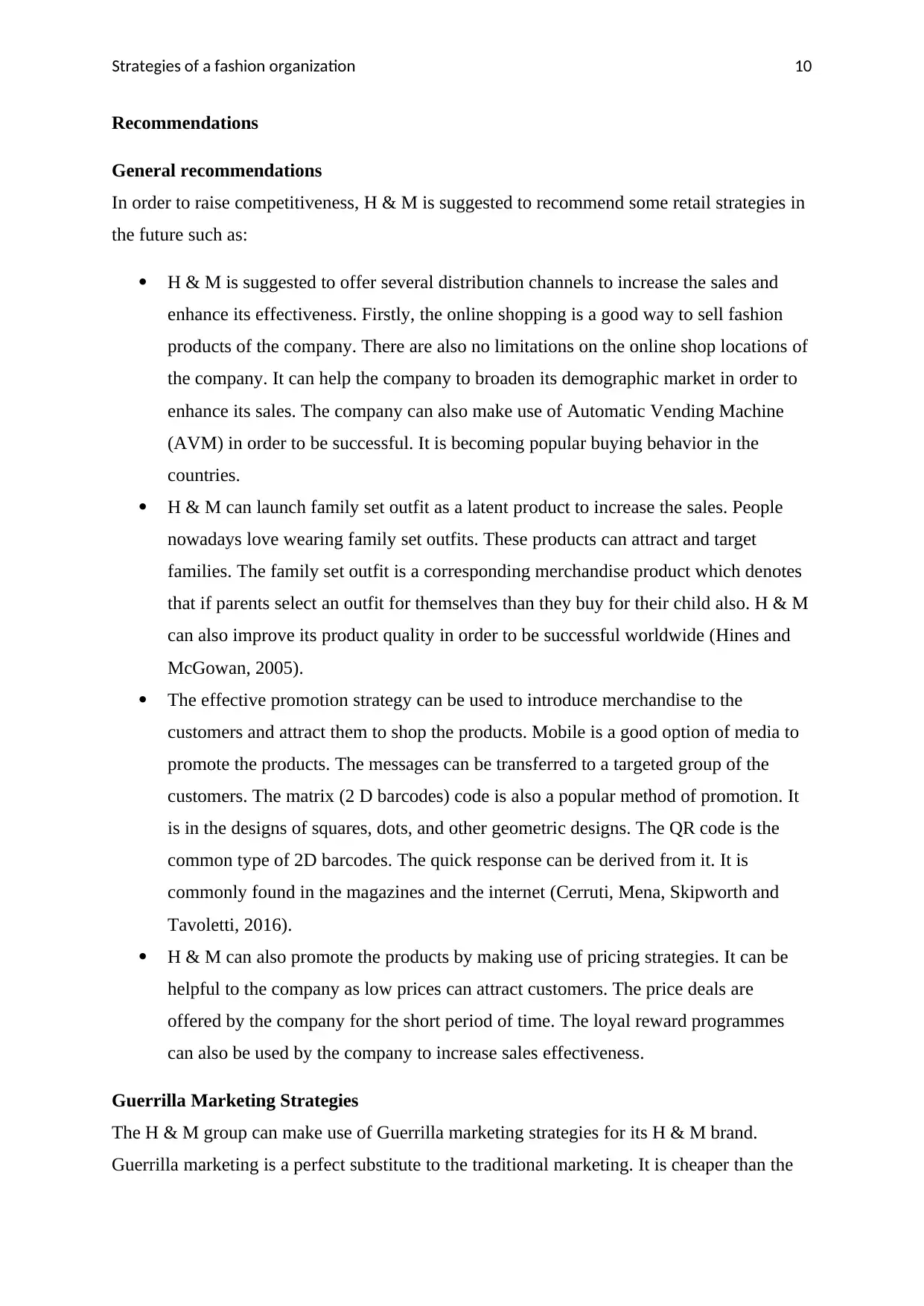
Strategies of a fashion organization 10
Recommendations
General recommendations
In order to raise competitiveness, H & M is suggested to recommend some retail strategies in
the future such as:
H & M is suggested to offer several distribution channels to increase the sales and
enhance its effectiveness. Firstly, the online shopping is a good way to sell fashion
products of the company. There are also no limitations on the online shop locations of
the company. It can help the company to broaden its demographic market in order to
enhance its sales. The company can also make use of Automatic Vending Machine
(AVM) in order to be successful. It is becoming popular buying behavior in the
countries.
H & M can launch family set outfit as a latent product to increase the sales. People
nowadays love wearing family set outfits. These products can attract and target
families. The family set outfit is a corresponding merchandise product which denotes
that if parents select an outfit for themselves than they buy for their child also. H & M
can also improve its product quality in order to be successful worldwide (Hines and
McGowan, 2005).
The effective promotion strategy can be used to introduce merchandise to the
customers and attract them to shop the products. Mobile is a good option of media to
promote the products. The messages can be transferred to a targeted group of the
customers. The matrix (2 D barcodes) code is also a popular method of promotion. It
is in the designs of squares, dots, and other geometric designs. The QR code is the
common type of 2D barcodes. The quick response can be derived from it. It is
commonly found in the magazines and the internet (Cerruti, Mena, Skipworth and
Tavoletti, 2016).
H & M can also promote the products by making use of pricing strategies. It can be
helpful to the company as low prices can attract customers. The price deals are
offered by the company for the short period of time. The loyal reward programmes
can also be used by the company to increase sales effectiveness.
Guerrilla Marketing Strategies
The H & M group can make use of Guerrilla marketing strategies for its H & M brand.
Guerrilla marketing is a perfect substitute to the traditional marketing. It is cheaper than the
Recommendations
General recommendations
In order to raise competitiveness, H & M is suggested to recommend some retail strategies in
the future such as:
H & M is suggested to offer several distribution channels to increase the sales and
enhance its effectiveness. Firstly, the online shopping is a good way to sell fashion
products of the company. There are also no limitations on the online shop locations of
the company. It can help the company to broaden its demographic market in order to
enhance its sales. The company can also make use of Automatic Vending Machine
(AVM) in order to be successful. It is becoming popular buying behavior in the
countries.
H & M can launch family set outfit as a latent product to increase the sales. People
nowadays love wearing family set outfits. These products can attract and target
families. The family set outfit is a corresponding merchandise product which denotes
that if parents select an outfit for themselves than they buy for their child also. H & M
can also improve its product quality in order to be successful worldwide (Hines and
McGowan, 2005).
The effective promotion strategy can be used to introduce merchandise to the
customers and attract them to shop the products. Mobile is a good option of media to
promote the products. The messages can be transferred to a targeted group of the
customers. The matrix (2 D barcodes) code is also a popular method of promotion. It
is in the designs of squares, dots, and other geometric designs. The QR code is the
common type of 2D barcodes. The quick response can be derived from it. It is
commonly found in the magazines and the internet (Cerruti, Mena, Skipworth and
Tavoletti, 2016).
H & M can also promote the products by making use of pricing strategies. It can be
helpful to the company as low prices can attract customers. The price deals are
offered by the company for the short period of time. The loyal reward programmes
can also be used by the company to increase sales effectiveness.
Guerrilla Marketing Strategies
The H & M group can make use of Guerrilla marketing strategies for its H & M brand.
Guerrilla marketing is a perfect substitute to the traditional marketing. It is cheaper than the
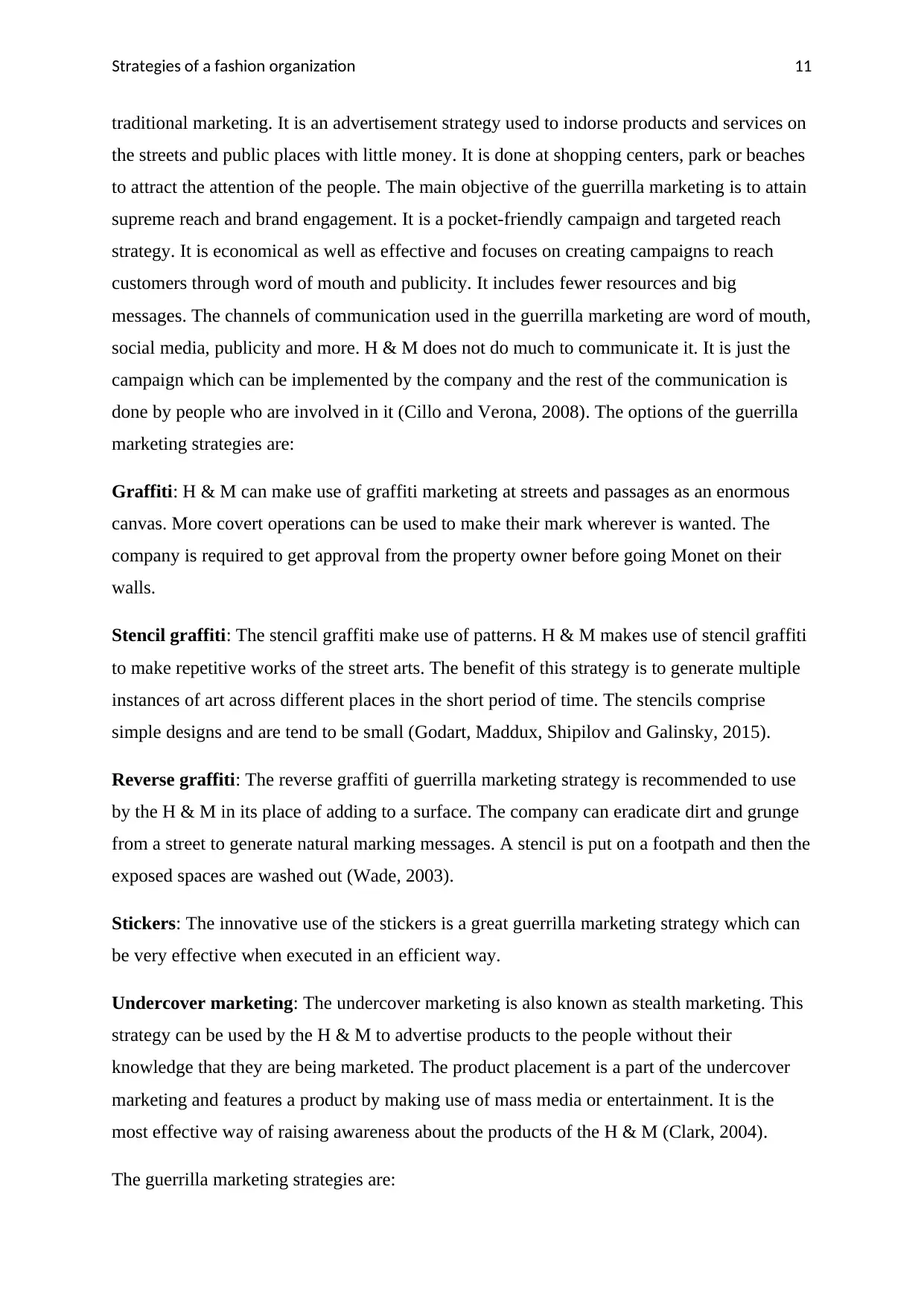
Strategies of a fashion organization 11
traditional marketing. It is an advertisement strategy used to indorse products and services on
the streets and public places with little money. It is done at shopping centers, park or beaches
to attract the attention of the people. The main objective of the guerrilla marketing is to attain
supreme reach and brand engagement. It is a pocket-friendly campaign and targeted reach
strategy. It is economical as well as effective and focuses on creating campaigns to reach
customers through word of mouth and publicity. It includes fewer resources and big
messages. The channels of communication used in the guerrilla marketing are word of mouth,
social media, publicity and more. H & M does not do much to communicate it. It is just the
campaign which can be implemented by the company and the rest of the communication is
done by people who are involved in it (Cillo and Verona, 2008). The options of the guerrilla
marketing strategies are:
Graffiti: H & M can make use of graffiti marketing at streets and passages as an enormous
canvas. More covert operations can be used to make their mark wherever is wanted. The
company is required to get approval from the property owner before going Monet on their
walls.
Stencil graffiti: The stencil graffiti make use of patterns. H & M makes use of stencil graffiti
to make repetitive works of the street arts. The benefit of this strategy is to generate multiple
instances of art across different places in the short period of time. The stencils comprise
simple designs and are tend to be small (Godart, Maddux, Shipilov and Galinsky, 2015).
Reverse graffiti: The reverse graffiti of guerrilla marketing strategy is recommended to use
by the H & M in its place of adding to a surface. The company can eradicate dirt and grunge
from a street to generate natural marking messages. A stencil is put on a footpath and then the
exposed spaces are washed out (Wade, 2003).
Stickers: The innovative use of the stickers is a great guerrilla marketing strategy which can
be very effective when executed in an efficient way.
Undercover marketing: The undercover marketing is also known as stealth marketing. This
strategy can be used by the H & M to advertise products to the people without their
knowledge that they are being marketed. The product placement is a part of the undercover
marketing and features a product by making use of mass media or entertainment. It is the
most effective way of raising awareness about the products of the H & M (Clark, 2004).
The guerrilla marketing strategies are:
traditional marketing. It is an advertisement strategy used to indorse products and services on
the streets and public places with little money. It is done at shopping centers, park or beaches
to attract the attention of the people. The main objective of the guerrilla marketing is to attain
supreme reach and brand engagement. It is a pocket-friendly campaign and targeted reach
strategy. It is economical as well as effective and focuses on creating campaigns to reach
customers through word of mouth and publicity. It includes fewer resources and big
messages. The channels of communication used in the guerrilla marketing are word of mouth,
social media, publicity and more. H & M does not do much to communicate it. It is just the
campaign which can be implemented by the company and the rest of the communication is
done by people who are involved in it (Cillo and Verona, 2008). The options of the guerrilla
marketing strategies are:
Graffiti: H & M can make use of graffiti marketing at streets and passages as an enormous
canvas. More covert operations can be used to make their mark wherever is wanted. The
company is required to get approval from the property owner before going Monet on their
walls.
Stencil graffiti: The stencil graffiti make use of patterns. H & M makes use of stencil graffiti
to make repetitive works of the street arts. The benefit of this strategy is to generate multiple
instances of art across different places in the short period of time. The stencils comprise
simple designs and are tend to be small (Godart, Maddux, Shipilov and Galinsky, 2015).
Reverse graffiti: The reverse graffiti of guerrilla marketing strategy is recommended to use
by the H & M in its place of adding to a surface. The company can eradicate dirt and grunge
from a street to generate natural marking messages. A stencil is put on a footpath and then the
exposed spaces are washed out (Wade, 2003).
Stickers: The innovative use of the stickers is a great guerrilla marketing strategy which can
be very effective when executed in an efficient way.
Undercover marketing: The undercover marketing is also known as stealth marketing. This
strategy can be used by the H & M to advertise products to the people without their
knowledge that they are being marketed. The product placement is a part of the undercover
marketing and features a product by making use of mass media or entertainment. It is the
most effective way of raising awareness about the products of the H & M (Clark, 2004).
The guerrilla marketing strategies are:
⊘ This is a preview!⊘
Do you want full access?
Subscribe today to unlock all pages.

Trusted by 1+ million students worldwide
1 out of 16
Related Documents
Your All-in-One AI-Powered Toolkit for Academic Success.
+13062052269
info@desklib.com
Available 24*7 on WhatsApp / Email
![[object Object]](/_next/static/media/star-bottom.7253800d.svg)
Unlock your academic potential
Copyright © 2020–2025 A2Z Services. All Rights Reserved. Developed and managed by ZUCOL.





